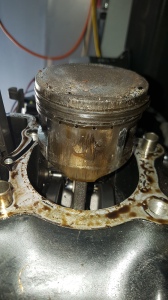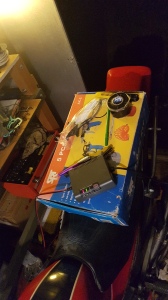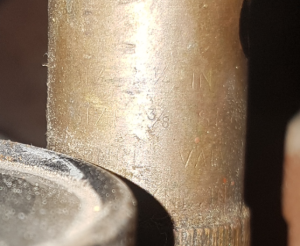Happy New Year!
I took last week and yesterday off from posting due to Christmas and New Year, but I was able to get a few things done over the holiday period.
Firstly, I got sick of hitting my head on the shed doorway, so I decided it was time to remedy the situation.
First up, here’s the doorway in question from outside and inside the shed.
I measured the height from the highest part of the threshold and found it to be exactly 170 cm
As I’m 183 cm (about 6 foot) tall, this is low enough to be a real hazard for bumping my head on. Fortunately my local hardware store sells reflective hazard marking tape. Here’s the view of the same doorway from inside and outside the shed now.
Next up, while I was using the air compressor to inflate the tyre on one of my wheelbarrows so I could do some work in the garden I decided to use the compressed air gun to clean some cobwebs out of the compressor itself. The brown acrylic paint started coming off some parts of the motor (mostly the plastic ones) but I noticed something new on the electric motor – a brand name!
A quick Google search told me that CMG is an Australian company that still makes electric motors. I haven’t had any luck identifying the motor model yet though.
Finally, I decided I was sick of working on Scarlet’s carburetor, so I decided to move onto the seized engine.
The two remaining mounting bolts for the cylinder were easy to remove.
The cylinder itself came off very easily too.
Inspecting the barrel didn’t reveal much at first glance.
Looking at the piston told another story, however!
It turned out the piston was seized to the dowel mounting it to the conrod.
As it wasn’t moving back and forth freely, there was some severe scoring on the outer side of the piston, most likely caused when the motor was turned over after it had seized.
With the piston free, I was finally able to maneuver the cam chain out.
I had another look at the inside of the cylinder and sure enough there was some nasty scoring on the outer side too, while the rear was relatively unharmed.
I removed the piston rings as best I could and cleaned the piston a little to look at the damage again
After only getting one circlip out and finding the mounting dowel to be completely immobile, I decided to use a hacksaw to crack the top of the piston open. After that, I was able to wedge a screwdriver in and split the piston completely.
I noticed some numbering “471” and “1” on the side opposite the “HON” and “DA” – this might indicate the original size or part number.
The conrod and mounting dowel seem to have seized together too. If this motor is going to run again, it’ll need a re-bore, oversized piston and most likely a new conrod as well, as I was a little overzealous with the hacksaw and left a few lines in the top of the conrod!
That’s all for now, regularly scheduled updates will return next week. The next update will most likely be an update on how Sylvie has handled not being ridden for nearly a month. I’m expecting a flat battery at the very least!











































































































































